|
The rainy morning of April 5 promised a gloomy, dispiriting day for
Confederate fortunes, a prognosis that events soon confirmed. The
quartermaster details began to return from their foraging expeditions,
empty-handed for the most part. There was simply no food to be had in
this region. Lee wasted little time on self-recriminations and issued
orders to resume the retreat. The path now would be southward, toward
Burkeville and North Carolina. Even as the hungry columns began to march
along the railroad line, the surplus artillery and supply wagons
lumbered off to the west to make a wide circle around the army's right
flank, beyond the reach of the Yankee cavalry. Behind them rumbled the
ominous sounds of explosions as the artillery stocks that could not be
transported were destroyed.
There was more bad news. The first concerned the supply train that
had come out of Richmond with Ewell's command. It too had been sent on a
circuitous route to allow the foot soldiers the more direct way, and
after struggling along the wearying course of muddy roads and swollen
streams, it had successfully reached a point
just seven miles northwest of Amelia Court House at Paineville. There it
had been struck by a force of bluecoated cavalry and virtually wiped
out. A rapid response by the Confederate cavalry posted nearby had badly
punished the raiders, but serious damage had been done. There had been
desperately needed supplies on that wagon train that were now
destroyed.
Lee's gamble to concentrate and
provision the army before the Federals could cut off its route south had
failed.
|
About 1:00 P.M. Lee himself rode down the rail tracks to check on the
progress of the march. Just outside Jetersville he found the leading
files drawn up in order of battle and halted. A quick personal
reconnaissance revealed only too clearly the fresh earthworks and
defiant battle flags of the enemy drawn in a line squarely across his
path. Lee's gamble to concentrate and provision the army before the
Federals could cut off its route south had failed. An artillery officer
with Lee remembered that the Confederate commander had never before
seemed "so anxious to bring on a battle . . . as he seemed this
afternoon," but the Union troops were too well posted.
The loss of this option seemed to befuddle Lee, who, in the words
of his capable corps commander James Longstreet, "hesitated as to his
course." At last the decision was made to shift the army's course from
south to west so that the men might reach a still usable stretch of the
South Side Railroad and there obtain supplies from Lynchburg. No local
guides could be found to direct this new course so Lee had to rely on
his maps. A soldier in the ranks who saw him at this time described
Lee's countenance as "very serious."

|
THE SKIRMISH NEAR AMELIA COURT HOUSE AS SKETCHED BY ALFRED WAUD. (LC)
|
Even as Lee was pondering this change of plan, the Yankees south of
Jetersville were being heavily reinforced. The first elements of the
Second and Sixth Corps began to arrive around 2:30 P.M. and immediately
went into position alongside the Fifth Corps and the cavalry. Hours
before this happened, Sheridan had sent out a full mounted brigade on a
sweep around the enemy's western flank to determine if the Rebels were
retreating that way. It was this force that came upon the virtually
unguarded Richmond wagon train near Paineville and wrecked it in an orgy
of sabering, pistoling, and arson. Recalled a New York trooper in those
ranks, "After sending the plunder on the road to Jetersville, the boys
were reminded that there was some of the Confederate cavalry still
alive, as a vigorous attack was made on their rear."
The intelligence that Lee's wagons were moving west, not south,
convinced Sheridan that Lee's infantry would soon follow suit. It was an
opinion not shared by the ranking officer on the field, George G. Meade,
who believed that Lee meant to make a stand at Amelia Court House. The
Army of the Potomac commander made his dispositions accordingly, with
the intention of enveloping the position from the south and east the
next day. Unable to change Meade's mind, Sheridan decided to go over his
head by sending a message to U. S. Grant asking him to come to
Jetersville at once.
The courier did not reach the lieutenant general (who was traveling
with Ord's columns) until well after dark, but Grant at once set off
cross country, accompanied only by a small escort. He reached Sheridan
shortly after 10:30 P.M., then the two went over to see Meade. The plans
were changed, and when daylight came the army would advance directly on
Amelia Court House.
The Army of Northern Virginia needed a few breaks if it were to
survive much past the night of April 5. It got a few, but they were
mostly bad ones. Speed was the life or death factor now, something that
proved impossible to attain. The few roads that wriggled west from
Amelia Court House were simply not sufficient to absorb the many men and
wagons under these conditions. Added to that, the wreckage from the
wagon train ambushed near Paineville and the generally poor condition of
the stream crossings conspired to turn this night march into a
stop-and-go nightmare.
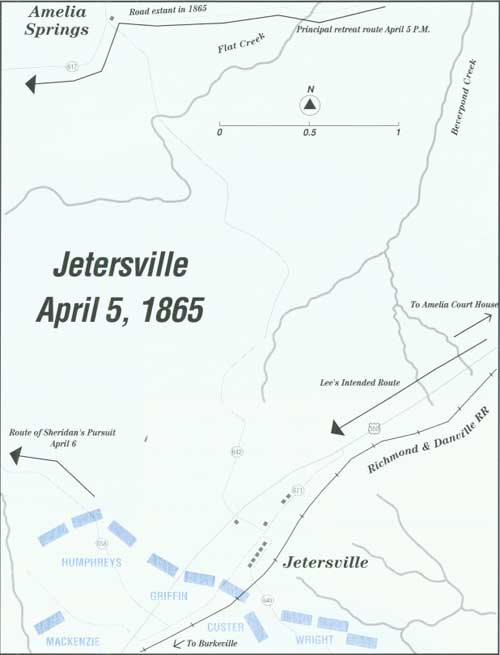
|
LEE BLOCKED
Lee expected to resupply his men at Amelia Court House and then to
follow the Richmond and Danville Railroad into North Carolina. But his
orders for rations to be waiting for him at Amelia were lost. Lee spent
24 hours in a futile attempt to gather supplies, losing what little lead
he had gained over Grant's forces. When Lee turned south on April 5, he
found that he was blocked at Jetersville. In no condition to fight, Lee
moved his weary army west.
|
As if Lee needed any further reason for urgency, he received from
General Gordon a dispatch found on two "Jessie Scouts" who had been
taken while masquerading as Confederates. The note, from U. S. Grant to
E. O. C. Ord, confirmed a strong Federal presence in Jetersville. (In a
message accompanying the captured document, Gordon asked if he was
expected to shoot these men as spies. "Tell the General," Lee replied,
"the lives of so many of our men are at stake that all my thoughts now
must be given to disposing of them. Let him keep the prisoners until he
hears further from me.")
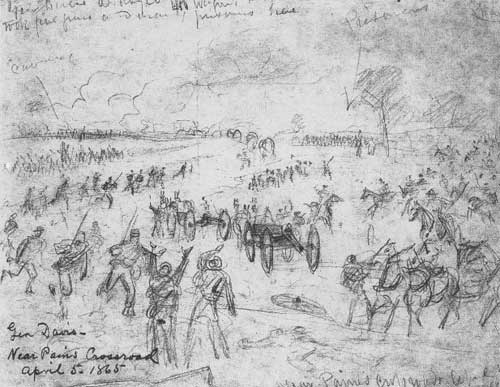
|
CAPTURE OF A CONFEDERATE WAGON TRAIN NEAR PAINEVILLE. (LC)
|
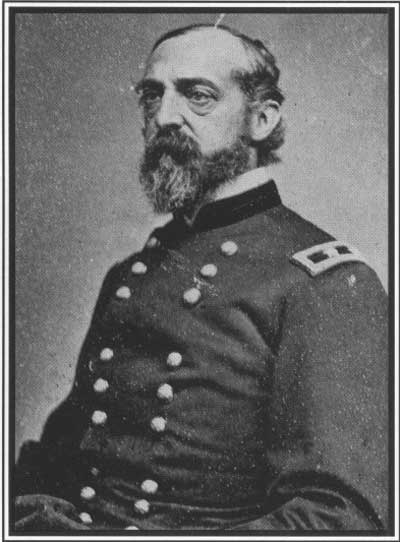
|
MAJOR GENERAL GEORGE G. MEADE (LC)
|
If things were bad at the beginning of this desperate night march,
they became even worse at daylight, April 6. For the first few miles
west of Amelia Court House, Lee's men had been able to pick up time by
moving along a series of parallel roads. But once beyond Deatonville
there was only a single track for the men, wagons, and animals to
follow. Lee expected that the hit-and-run Yankee riders would reappear
on his left flank at dawn, but other than issuing orders for the long
files to keep closed up, there was little he could do. As the various
commands were funneled onto the single road past Deatonville, the order
of the march became, first Longstreet's Corps (made up of the First and
Third Corps), followed by the commands of Anderson, Ewell and Gordon,
with most of the wagons between the last two.
Lee rode ahead to the goal of this day's movement, Rice's Station on
the South Side Railroad. He was there when Longstreet's men began to
arrive during the morning, followed by three divisions once under the
late A. P. Hill but now reporting to the First Corps commander. Then,
ominously, the steady flow of men dropped to a trickle. Lee spent the early
afternoon preparing defensive positions against Federals advancing west
from Burkeville and getting things in order for the next day's march. He
then nervously rode back along the route to determine what was holding up nearly half of his
army.

|
LIEUTENANT GENERAL ULYSSES S. GRANT AND HIS STAFF AT CITY POINT, VIRGINIA. (LC)
|
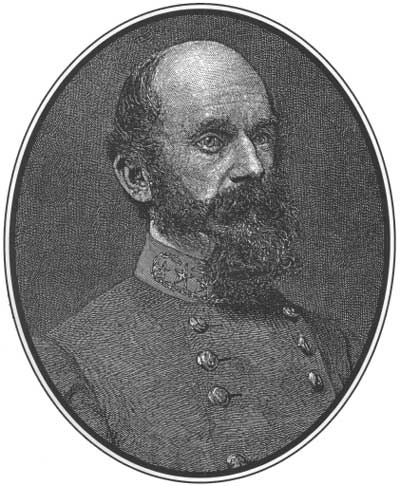
|
LIEUTENANT GENERAL RICHARD S. EWELL (BL)
|
The three Union infantry corps at Jetersville began a slow advance
toward Amelia Court House around 6:00 A.M., while most of Sheridan's
cavalry galloped off to the west. Explained General Meade's aide,
Theodore Lyman, "We did not know just then, you perceive, in what
direction the enemy was moving." By 9:00 A.M. it was clear that the
entire Rebel force had shifted west, toward Deatonville. The pursuit was
immediately resumed, with the Second Corps (under Major General Andrew
A. Humphreys) pressing the enemy rear guard, supported by the Fifth
Corps. The Sixth Corps (commanded by Major General Horatio Wright) moved
to follow the cavalry, which was thrusting ahead with a cocky
aggressiveness. "Today will see something big in the crushing of the
rebellion," one of Sheridan's brigadiers, Charles H. Smith,
predicted.
The situation was well-suited to the quick-moving cavalrymen armed
with fast-firing breech-loading weapons. The Confederate march was
strung out along a single road, with weary groups of foot soldiers
trying to watch over miles of lumbering wagons. Time and again small
parties of bluecoated riders would dash at an exposed section of
vehicles, shooting horses and drivers and raising general havoc before
the security units could react to drive them off. And these attacks were
not always small ones. Near a road intersection known variously as
Holt's or Hotts Corner, Brigadier General Charles Smith led most of his
brigade in a charge on the Rebel column but met the massed rifles of
Richard Anderson's corps and was repulsed. This action forced Anderson's
men to halt, however and by the time they resumed the march the gap
between them and the units preceding them under Longstreet had widened
to an alarming degree. And during the time Crook had been keeping
Anderson occupied, other mounted units were moving into that gap to cut
the road.
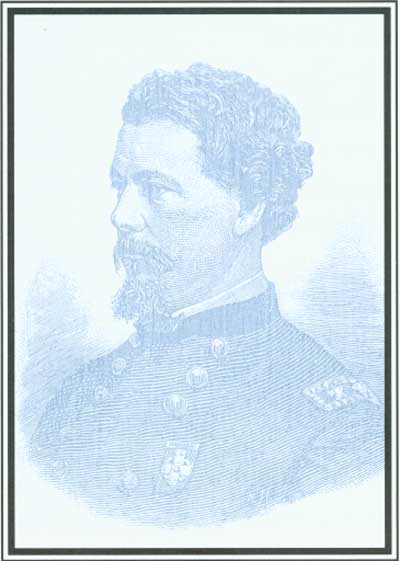
|
MAJOR GENERAL HORATIO G. WRIGHT (BL)
|
Once Anderson's command cleared the crossroads, it continued toward
the crossing of Little Sailor's Creek from where it would proceed to
Rice's Station. Behind Anderson came Ewell's mixed command drawn from
the Richmond defenses, then the hulk of the wagons, and finally Gordon's
Corps, which had its hands full fending off General Humphreys's hot
pursuit. "On and on, hour after hour, from hilltop to hilltop, the lines
were alternately forming, fighting, and retreating, making one almost
continuous shifting battle," Gordon recalled. Then Ewell learned from
the cavalry commander Fitzhugh Lee that the Yankees had gotten in front
of Anderson, bringing his corps to a halt.
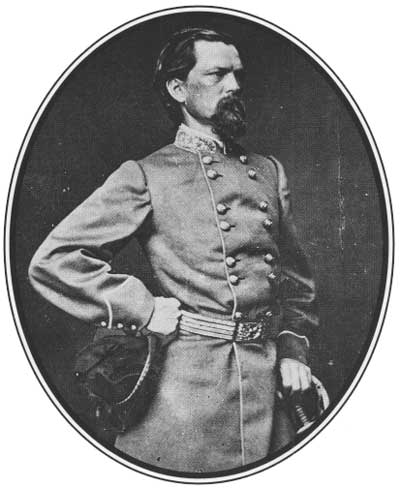
|
MAJOR GENERAL JOHN B. GORDON (LC)
|
Ewell now made a fateful decision. He ordered the supply wagons to
turn off the main route at Holt's Corner, to follow a trail leading off to the
northwest, which eventually reconnected with roads to Rice's Station.
Although he never issued Gordon any formal instructions to stick with
the wagons, that is what Gordon did, turning his corps to follow. Ewell's
men, in the meantime, took up a defensive position (facing east and
northeast) along the high ground on the west side of Little Sailor's
Creek.
The Federal Second Corps never broke contact with Gordon's men and
also turned northwest at Holt's Corner. But the roads behind Humphreys's
men were quickly filled with troops from Wright's Sixth Corps, which had
come up from the south in support. These soldiers, now pushing after
Ewell, were soon lining the high ground east of Little Sailor's Creek.
The effect of all this was to place Anderson's and Ewell's commands
virtually back-to-back, with Yankee cavalry before Anderson and Union
infantry confronting Ewell. The Confederates were boxed in, neat and
simple. "The odds against us were fearful," recalled a Virginia Rebel
named R. S. Rock.
Ewell had no artillery with him and so was unable to reply when, at
5:15 P.M., a row of 20 Yankee cannon lined up along the ridge opposite
his position opened a concentrated fire that lasted for more than 30
minutes. A Maryland officer on the receiving end of the barrage recalled
the "shot sometimes plowing the ground, sometimes crashing through the
trees, and not infrequently striking in the line, killing two or more at
once." Behind the curtain of powder smoke Federal battle lines took
shape. At 6:00 P.M. the guns fell silent and the infantry formations
began to advance.
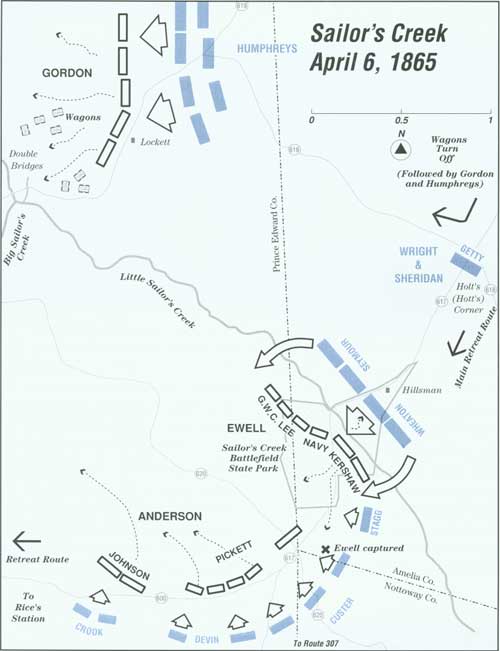
(click on image for a PDF version)
|
A CATASTROPHIC DEFEAT
Harassed on its flanks by Sheridan's cavalry, and pressed heavily by
Federal infantry under Wright and Humphreys, Lee's retreating column
began to lose cohesion. A fatal gap opened between the more quickly
moving head of the column under Longstreet and the tail under Anderson,
Ewell and Gordon. Sheridan's horsemen exploited the gap to cut off
Ewell, who took a position along Little Sailor's Creek. Further north,
Gordon was able to break contact with Humphreys, though he lost many
valuable supply wagons. Ewell was attacked by Wright whose men
overwhelmed the Rebel force after brief but bitter combat. Approximately
8,000 Confederates, including eight generals, were killed, wounded or
captured. Said Lee, "A few more Sailor's Creeks and it will be over."
|
Up to this time Richard Anderson had successfully beaten back several
small-scale attempts by Sheridan's cavalry to burst through his
position. Sheridan's response was to put more muscle into the effort. He
organized a combined charge by the divisions under Brigadier General
Thomas C. Devin and Brevet Major General George A. Custer. An awestruck
onlooker later wrote, "The fire as they neared the rebel line was
terrific, opening gaps in their lines, but if a horse was shot & the
rider unhurt he would jump up [and] take his place, firing as he went."
With a last rush, the troopers were in among the Confederate defenders.
"The scene at this time was fierce and wild," a West Virginia trooper
named F. C. Robinson recalled, "but the saber, revolver and Spencer
carbine of the cavalry were too much for the bayonet, and the musket
that could not be quickly loaded."
Anderson's left flank was overwhelmed and his center collapsed by the
force of this assault. The defense simply disintegrated (one Federal
trooper later wrote of the sight of Confederate soldiers "scattering
like children just out from school"), though several units did leave the
field under discipline. Of the 6,300 or so men Anderson marched into
this fight, nearly 2,600 were killed or captured, mostly the latter.
Even as the fight along Little Sailor's Creek was moving toward its
climax, the collapse of Anderson's command meant that Ewell's best
escape route was closed.
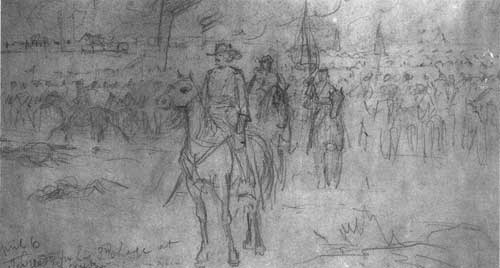
|
CUSTER PREPARES FOR A CHARGE AT SAILOR'S CREEK. (LC)
|
A few miles north of where all this was taking place, disaster was
also catching up with the main supply train which Ewell had shunted away
in an effort to save it. This detour took the wagons, followed by
Gordon's corps, followed closely by Humphreys's corps, to the eastern
edge of a long valley, at the base of which ran Sailor's Creek. A set of
two successive bridges (known as the "Double Bridges") proved unable to
handle the volume of traffic, causing the wagons to jam up in the nearby
lowland. Gordon's men took up a defensive line along the eastern rim of
the valley in the hope of holding it long enough for the wagons to
escape, but the Federal soldiers would not be denied. In a terribly
short time, Gordon's troops were shoved off the ridge. Battered
infantrymen fell back among the wagons, where chaos reigned for a while,
with fighting men intermixed with frantic teamsters and terrified
animals. By the time Gordon was able to extract his command and position
it astride the west side of the valley, he had lost nearly 2,000 men,
along with three cannon, 200 wagons, and 70 ambulances.
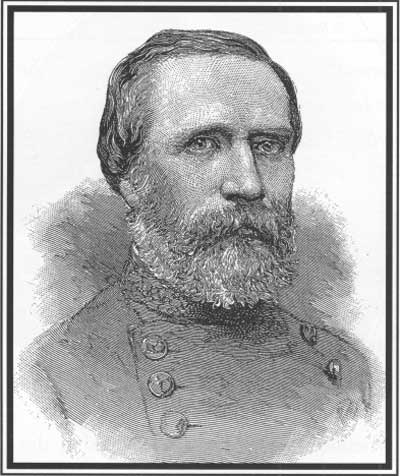
|
LIEUTENANT GENERAL RICHARD H. ANDERSON (BL)
|
Back along Little Sailor's Creek, it seemed for a few brief minutes
that Ewell's beleaguered command might be able to stave off the enemy.
The center of the attacking Federal line, outdistancing the flanking
wings, charged unsupported up the hill. It became the concentrated
target of Confederate rifle fire from both front and flank, reeled back
in a panic, and was even chased by a small Rebel force led by Major
Robert Stiles. The retreating Yankees got far enough ahead of their
pursuers to unmask the cannon lined along the creek bank, and a
hellstorm of canister and shrapnel blanketed the impetuous Confederates,
who pulled back.

|
THE SURRENDER OF EWELL'S MEN AT SAILOR'S CREEK AS DEPICTED BY
ALFRED WAUD. (LC)
|
By now the flanking Union regiments had overlapped both ends of
Ewell's line and the whole thing began to fold in on itself. A few
Confederate units (most notably, the Naval Battalion) fought with
desperate ferocity, but the end was inevitable. Ewell himself
surrendered to a sergeant from the 5th Wisconsin near Swep Marshall's
house. Also entering captivity were nearly 3,400 of the approximately
5,300 men he commanded. Counting all the troops engaged along or near
Sailor's Creek this day (Ewell's, Gordon's, and Anderson's), Lee's
losses totaled approximately 8,000. The Federals later reported
casualties of about 1,200. In his brief report of the victory at
Sailor's Creek, Sheridan told Grant, "If the thing is pressed I think Lee
will surrender."
|
THE ADVENTURES OF PRIVATE EDDY
Bell Irvin Wiley, in his classic volume, "The Life of Billy Yank,"
wrote that "of the countless feats of individual valor cited in official
records, none was more remarkable than that of Private Samuel E. Eddy of
the Thirty-seventh Massachusetts Regiment...."
Eddy was a blacksmith and woodturner by trade until finally the
clouds of war beckoned his service to the Union on July 20, 1862, in
Company D. He passed through most of his regiment's fighting relatively
unscathed until April 6, 1865, during Lee's retreat from Richmond and
Petersburg.
While the Confederate army was marching toward the town of Farmville,
it passed over a series of water courses that emptied into the
Appomattox River. One was known locally as Little Sailor's Creek. While
the line of march of the Southerners was crossing this small stream,
Union troops from the 6th Corps (of which the 37th Massachusetts was
part) intercepted them at this point. In command of the immediate
Confederate forces was Gen. Richard S. Ewell who had with him units
under Gen. George Washington Custis Lee, Gen. Joseph Kershaw's division
and a small group of marines and sailors.
As two divisions of Union Gen. Horatio Wright's 6th Corps arrived on
the scene, preparations were made to do battle with the Southerners, who
were dug in on the opposite high ground overlooking the creek. After
nearly half an hour of artillery bombardment on the exposed Confederate
troops, the Union soldiers moved down to and across the creek, then
formed to begin their assault on Ewell's position. As this was
transpiring, one of Eddy's colleagues remembered that "Private Eddy was
obliged to fall from the ranks, being about 44 years of age, and having
been wounded in the knee March 25 previous—less than two weeks
previous. To the surprise of his officers and comrades, he found the
regiment and joined it...."
In their initial approach upon the enemy line, the Union troops were
received by an impromptu counterattack by Custis Lee's men. Deadly
hand-to-hand fighting took place as the two sides came together. Some of
the Northern regiments were forced back to the creek, while others, like
the 37th Massachusetts, held their ground. Under the fire of artillery
again, the Confederates fell back to their slight breast-works. Finally,
the Union soldiers reformed and began their ascent once more, this time
overlapping the flanks of the Southern position. Though brief in time,
both armies struggled desperately before Ewell's men began to surrender.
Gen. Custis Lee is said to have given his sword to a member of the 37th.
It was during this time that Sam Eddy had his ordeal.
The colonel of the 37th, Oliver Edwards, remembered that:
"The Colonel next in command (of Lee's forces) was in the act of
handing his sword to adjutant (John S.) Bradley, when, seeing how small
was the command (300 men) opposed to him, he drew back his sword, and
attacked the adjutant with his pistol. Bradley grappled with his foe
though wounded by his pistol shot (passing near his shoulder
blade)—and they rolled into a hollow, where surrounded by rebels,
Bradley was shot through the thigh, when Samuel E. Eddy private Co. D.
shot the rebel Colonel as he was about to shoot Bradley through the head
with his pistol. A rebel who saw the man who killed his Colonel—put
his bayonet through private Eddy's body, the bayonet passing through the
lung and coming out near his spine. Eddy dropped his gun, and tore the
bayonet out from his body, then in a hand to hand struggle with his foe
temporarily disabled him and crawled to his gun, and with it killed his
antagonist."
William Shaw, also of the 37th, remembered:
"I saw him (Eddy) after the battle sitting on the ground. I says to
him are you wounded? He said they have run a bayonet through me. I
looked and saw where it entered his body and came out on his back. He
said it did not hurt so very much when it went through, but the man
twisted it when withdrawing it but the man never bayoneted another
soldier, for Mr. Eddy was so indignant, that he shot him then and
there."
Sam Eddy's war service was over. Initially taken to a nearby field
hospital on the battlefield, he eventually was transferred to a larger
hospital at Burkeville Junction. A few days later he was sent by train
and placed in the Depot Field Hospital in City Point where he
recuperated from his wound. His treatment was for a bayonet wound in the
breast with the weapon entering between the third and fourth ribs and
passing through near the spine. He was mustered out June 9, 1865.
Because of his heroism in saving the life of Adjutant Bradley,
Private Eddy in 1897 would be issued a Medal of Honor for gallantry at
the Battle of Little Sailor's Creek. On March 7, 1909, the old Civil War
veteran passed on and was buried in Chesterfield, Mass.
|
|
|
